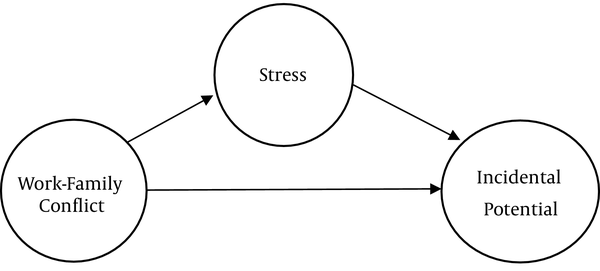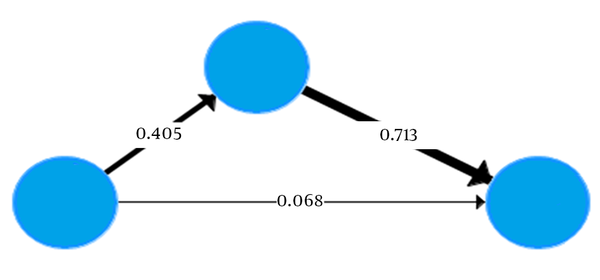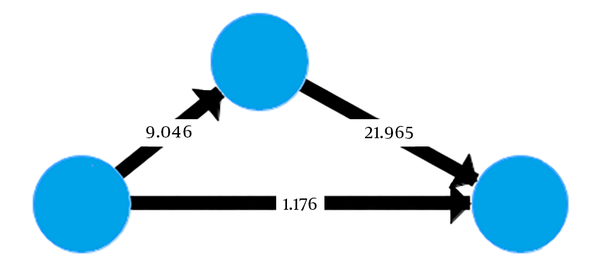1. Background
In today’s competitive world, industries are the most economically efficient factors in societies, which may lead to the expansion and development of these societies and increase their productivity and economic growth. Besides the positive impact of Industrial development and the advancement of technology, there are some negative aspects and complications, such as increasing environmental pollution, job accidents, and diseases, which in fact are the consequences of the development of industry and technology that threaten human life. It is important to note that most people in the world (more than 58%) spend one-third of their life at work (1). Some of these risk factors are: Stress, work-family conflict, work-job rewards, and job imbalance (2). The conflict of work-family is a kind of conflict between the role in which the pressures from job and family roles are disparate from both sides or at least in some ways. This means that it is difficult to play a job or family role. When two or more roles are taken by one person, a conflict occurs between the role where the work-family conflict is one of those conflicts (3). Job stress is a condition of work-related anxiety and stress that affects the mental and physical health of a person. It can also affect the person’s behavior in the job (4). Highly stressed working environments can have a negative impact on the persons safety and their safe behavior as well as increase the risk of injury (5). Stress is the force that changes its shape when it comes to pressure on a set. Job stress is the interaction between working conditions and individual characteristics, thus, the demands of the workplace are more than the person can handle. When a job becomes stressful it does not provide sufficient incentives and support for an individuals’ job needs, such as a safe working environment (6). The annual economic cost of work-related accidents and injuries in the United States is estimated to be around 142.2 billion dollars, while four million non-fatal accidents and 5734 deaths occurred in 2015 (7, 8). Therefore, 80 working days were lost due to these injuries (7). According to the available statistics in Iran, the job accidents increased from 15552 cases in 2000 to 16745 cases in 2003, in which the percentage increase number was 7.67% (9). Job injuries have an impact on families. For example, Morse, Dillon, Warren, Lonestine, and Warren stated that the ratio of divorce in damaged workers is bone-in compared to healthy workers 1.9 (10). To prevent these accidents, finding the real causes of them is required. There is no single reason for these accidents, not only can it be due to job conditions, many psychosocial factors in working environments can affect the various aspects of worker’s health. Researches show that these factors play a very important role in the occurrence of accidents (11). Psychosocial risks are among the most important emerging risks in working environments, like work-family conflict, working life quality, and stress, which might result in unreasonable and out of control behavior in working environments (12). According to the report of South Korean Occupational Health and Safety Agency, work-related deaths in this country, in 2010, were about 1800 cases, which cost $2 million in South Korea and $5 million in the United States. According to the information of the International Labor Organization in 1994, the reported fatal job accidents were 14 deaths per 100000 of the population and the total number of fatal accidents were 335000 cases. According to the report of Lee et al. around 33% to 69% of these accidents will never report in job accident reports (13). According to the report provided by EME countries that included Western Europe countries, North America countries, and Japan, the job accident rate was around 62%, while in India and some other countries it was reported to be close to zero; however, according to the International Labor Organization, these statistics are not real (14). The purpose of this research is to survey the psychosocial factors (stress, work-Family conflict), and evaluate the relationship of these factors with job accidents among the workers of a construction project of fiber optic cable located between Tehran and Shahrood. Therefore, by determining the factors affecting these variables, we will take steps to improve the quality of work environments. Figure 1 shows the proposed pattern in this present research.
2. Objectives
The present correlation research is a type of sectional-analytical study, which is conducted with the aim of PLS path modeling of the relationship between the work-family conflict and job accident with mediating role of stress, to provide a model for job accidents among the workers of fiber optic cable project. The objectives of this research include: (1) To examine the relationship between work-family conflict with the potential of the accident; (2) to examine the relationship between stress and the potential of the incident; (3) to examine the relationship between work-family conflict with the stress; and (4) to examine the role of mediation of stress between work-family conflict and the potential of the incident.
3. Methods
3.1. Study Area
This research was conducted in a constructive project of a fiber optic cable located between Tehran and Shahrood, for a period of one year.
3.2. Sampling and Analytical Methods
This under research population is a set of real or hypothetical members who have measurable characteristics and the research results can be generalized to them. The target population in this research include all employees. The total population in this research is 600 people. Hair et al. suggests that the sample size can be driven by the following steps in a structural equation modeling technique: The statistical significance level (0.05), statistical power (0.8), the low R-squared values in the model (R2), and the maximum number of arrows pointing to a hidden variable in the partial least squares structural equation modeling (PLS-SEM) path model (15). Accordingly, when the maximum number of the independent variables in this measurement and structural model is two, to reach an 80% statistical power and to obtain an R-squared value (R2) equal to 10% (with 5% error probability), the minimum size of the required population is 110. Considering this fact that the higher sample size increases the accuracy (compatibility) of partial least squares structural equation modeling estimates (16), the sample size, which is randomly selected, is 225 employees.
The PLS-SEM3 method has been used for modeling the above-mentioned connections. The procedure used for PLS-SEM is (1) compilation of the structural model; (2) compilation of measurement models; (3) data collection and analysis; (4) estimation of SEM-PLS Model and Algorithm; (5) evaluation of PLS-SEM results for measurement models; (6) evaluation of PLS-SEM results for structural model; and (7) results analysis. The path models are made up of two components, the structural model, also called in the PLS-SEM, the inner model, describes the relations between the variables, and the measurement model, external model, shows the corresponding in the relationships between the variables and the measurements. Both measurement and structural models must be evaluated in this method to prove the validity and reliability of the results. The steps are as following:
3.3. Measurement Model Evaluation
3.3.1. Individual Item Reliability
The reliability of each item refers to the factor load of each of the observed variables. In addition, it is also used to determine if the measurement indicators (observed variables) are acceptable to measure hidden variables; the 0.6 acceptable minimum value represents a moderate mean level. These values are determined by the software.
3.3.2. Composite Reliability (Syntactic Stability of Each Structure)
This test seeks to prove the existence of an internal consistency between the model’s reagents, its value is obtained by the Equation 1. λI is indicated as a load of each reagent and var (εi) is indicated as a variance of each reagent. Values above 0.6 are acceptable.

3.3.3. Convergent Validity (Average Variance Extracted)
Convergent validity is the third criterion used to fit measurement models in the partial least squares method. The mean of the variance extracted shows the correlation of a structure with its own indices. The mean value of the extracted variance is high (0.5), which is an acceptable convergent validity.
3.3.4. Differential Validity
The Fornell-Larcker criterion is a conservative approach to differential judgment. This root-meanness criterion (root) compares the AVE value with the correlation between the variables. Specifically, the root of each construct AVE must be greater than the highest correlation of that structure with other model structures. The logic of this approach is based on the assumption that a structure should share more variance with corresponding reagents to other structures (15).
3.4. Structural Model Evaluation
3.4.1. Evaluating the Structural Models for Collinearity Issues
It occurs when two or more independent variables are highly correlated and when the variance inflation factor (VIF) is greater than five or the tolerance is greater than 0.2.
3.4.2. Evaluating the Significance of Coefficients
In order to investigate the existence or non-existence of the relationship between variables, all of the existing relationships between the variables in the model should be meaningful. For this purpose, at a 95% confidence level, the significance (T) of all paths is compared with 1.96 and values greater than 1.96 are acceptable.
3.4.3. Coefficient of Determination (Evaluation of R<sup>2</sup>)
The most common measure used to evaluate the structural model is the coefficient of determination (R2 value). This coefficient is a precision model for forecasting. Three values of 0.67, 0.33, and 0.19 are introduced as a criterion value for strong, moderate, and weak values.
3.4.4. Evaluating the Effect Size f<sup>2</sup>
A change in the value of R2 can be investigated when a certain exogenous structure is eliminated from the model to evaluate whether the removed structure has a significant effect on the intrinsic structures. This measure is referred to as f2. The size of this effect is calculated using the following Equation 2:

The values of 0.2, 0.15, and 0.35 for f2, respectively, show the small, medium, and large effects of exogenous variables.
3.4.5. Prediction Accuracy (Q2)
Data points predict the reflective reciprocation of the intrinsic structures. The analysis of its values is like the values of f2.
3.4.6. Goodness of Fit Model (GOF)
To calculate it the Equation 3 should be used (15).

3.5. Data Collection Tools
The following four questionnaires are used for data collecting:
1- Researcher-made questionnaire to collect demographic information on population, including age, education, marital status, and work experience.
2- Job stress questionnaire (17).
3- Work-family conflict questionnaire (18).
4- Accident proneness questionnaire (19).
The above questionnaires are all standard and have a reference; the Cronbach’s alpha value for each of them is calculated to be 0.87, 0.82, and 0.91, respectively.
4. Results
Structural equation modeling (SEM) is used for evaluating the proposed model of the relationship between the work-family conflict and accident proneness with the mediating role of job stress (Figure 2).
4.1. Research Objectives Testing
As shown in Figure 3, except the path from work-family conflict to accident proneness, the level of significance in all paths is greater than 1.96 (15).
4.2. Measurement and Structural Models Evaluation Result
Table 1 shows the results of the test of the measurement and structural model. The three values 0.01, 0.25, and 0.36 are considered as weak, moderate, and strong values for GOF. The achievement of 0.43 indicates the high fit of the research model. Therefore, due to the suitability of this research model, the subsequent calculations and research hypothesis testing can be followed with confidence (20).
| Variable | Collinearity Issues (VIF) | f² | ||||||
|---|---|---|---|---|---|---|---|---|
| Stress | Incidental Potential | W-F Conflict | Stress | Incidental Potential | W-F Conflict | |||
| Stress | 1.19 | 0.950 | ||||||
| Incidental potential | 1.19 | |||||||
| W-F conflict | 1 | 0.196 | 0.009 | |||||
| R2 | Q2 | Com-R | Con- V | GOF | Forner-Larker | |||
| Stress | 0.164 | 0.077 | 0.939 | 0.526 | 0.43 | 0.725 | ||
| Incidental potential | 0.552 | 0.276 | 0.822 | 0.537 | 0.720 | 0.732 | ||
| W-F conflict | - | - | 0.963 | 0.595 | 0.330 | 0.295 | 0.771 | |
Measurement and Structural Models Evaluation Result
4.3. Survey the Significance of Mediator Effects
Step 1: In Figure 4 the significance of the direct effect of work-family conflict and accident proneness without the mediating role of job stress is shown.
Figure 4 shows that work-family conflict has a meaningful relationship with accident proneness.
Step 2: In Figure 3 the significance of the direct effect of work-family conflict and accident proneness with the mediating role of job stress is shown.
Figure 3 indicates the significance of the indirect effect of the work-family conflict on accident proneness.
4.4. The analysis of “Variance Accounted for” (VAF):
To determine the severity of stress, mediating variable’s effect the relationship between work-family conflict and accident proneness.
According to Figure 2 (the display of the paths in PLS graph).
VAF = (0.40 × 0.71) / (0.40 × 0.71 + 0.06) = 0.82
5. Discussion
Based on the results obtained from software modeling, there is no relationship between work-family conflict and accident potential. In 2011 and the same study, McNamara et al. studied a 150-person community study in Australia with a view to assessing the length of working hours, family-work-life conflicts, and the health of hotel staff in Australia. They found that there is a significant relationship between work-family conflict and individual health, and increasing individual health can reduce conflict. In 2013, Hammig and his colleagues studied the relationship between mental, physical, and mental health with work-family conflict. This study was conducted in the Swiss industry and its results show that among the 2014 students, there is a significant relationship between conflict and health. The results of this research were contrary to these studies and did not show a significant relationship between work-family conflict and accident potential.
This study also showed that there is a significant relationship between stress and accident potential. Maria Jolie and her colleagues examined the relationship between job stress and occupational accidents in Spain in 2013. The results show that there is a significant relationship between occupational accidents and lack of organizational support as a characteristic of stress. Yong-Seok and his colleagues examined occupational stress as a factor for absenteeism due to accident and illness in 2015. Finally, they found that there was a direct and significant relationship between occupational stress and absence from work due to an accident, this factor could also affect the development of the disease. Linda M. Goldenhar and his colleagues studied the relationship between occupational stress and injuries and similar incidents in the construction industry in 2003. The result is that some stressors such as job requirements, exposure time, and training have a direct relationship with pseudo-accidents and injuries. Other stressors also had an indirect relationship with job injuries. It also showed that occupational stresses, as well as physical and psychological conditions, could be a factor in the occurrence of accidents in the construction industry. All of the above studies show similar results to the results of this study.
The results of the study indicate the relationship between work-family conflict and stress. Darcy et al. conducted a study entitled Work-family conflict: An exploration of the differential effects of a dependent child’s age on working parents in 2007, and Hennessy, K. D. and colleagues conducted a study entitled Self-efficacy for managing work-family conflict: Validating the English language version of a Hebrew scale in 2008. The results of these studies, like the present study, confirm this relationship.
Regarding the role of the mediator of occupational stress between individual and social factors, the Prechter and Hayes approaches that distribute indirect exclusion sampling are Bootstrap and are quite suitable for PLS-SEM. Variance accounted for (VAF) showed that 82% of the work-family conflict effect on incident talent is indirectly distinguished by the stress mediator variable, which represents a complete mediation of stress in the relationship between work-family conflict and incident potential.



